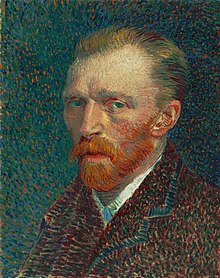Vincent Van Gogh made a brief stop this fall at the Butler Institute of American Art in Youngstown, Ohio and William and I were fortunate enough to be able to view it.
In the Dunes was painted by Van Gogh in 1883 and is in the collection of a private art patron, who generously allowed it to be loaned to the Butler.
Information from Wikipedia:
| Vincent van Gogh | |
|---|---|

Self-Portrait, Spring 1887, Oil on pasteboard, 42 × 33.7 cm., Art Institute of Chicago (F 345)
| |
| Born | 30 March 1853 Zundert, Netherlands |
| Died | 29 July 1890 (aged 37) Auvers-sur-Oise, France |
| Education | Anton Mauve |
| Known for | Painting, drawing |
| Notable work | Starry Night, Sunflowers, Bedroom in Arles, Portrait of Dr. Gachet, Sorrow |
| Movement | Post-Impressionism |
Vincent Willem van Gogh
30 March 1853 – 29 July 1890) was a Post-Impressionist painter. He was a Dutch artist whose work had a far-reaching influence on 20th-century art. His output includes portraits, self portraits, landscapes and still lifes of cypresses, wheat fields and sunflowers. He drew as a child but did not paint until his late twenties; he completed many of his best-known works during the last two years of his life. In just over a decade, he produced more than 2,100 artworks, including 860 oil paintings and more than 1,300 watercolors, drawings, sketches and prints.
Van Gogh was born to upper middle class parents and spent his early adulthood working for a firm of art dealers. He traveled between The Hague, London and Paris, after which he taught in England at Isleworth and Ramsgate. He was deeply religious as a younger man and aspired to be a pastor. From 1879 he worked as a missionary in a mining region in Belgium, where he began to sketch people from the local community. In 1885 he painted The Potato Eaters, considered his first major work. His palette then consisted mainly of somber earth tones and showed no sign of the vivid coloration that distinguished his later paintings. In March 1886, he moved to Paris and discovered the French Impressionists. Later, he moved to the south of France and was influenced by the strong sunlight he found there. His paintings grew brighter in color, and he developed the unique and highly recognizable style that became fully realized during his stay in Arles in 1888.
After years of anxiety and frequent bouts of mental illness,[1][2] he died aged 37 from a self-inflicted gunshot wound. The extent to which his mental health affected his painting has been widely debated by art historians. Despite a widespread tendency to romanticize his ill health, modern critics see an artist deeply frustrated by the inactivity and incoherence wrought through illness. His late paintings show an artist at the height of his abilities, completely in control, and according to art critic Robert Hughes, "longing for concision and grace".[3]





No comments:
Post a Comment